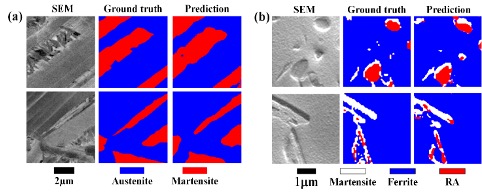Microstructure
Segmentation and Quantification of Advanced Steels Combining EBSD and Deep
Learning
Chunguang Shen, Chenchong Wang, Wei Xu*
Northeastern University, Shenyang, 110819,
China
ABSTRACT: Recently,
some material experts have started exploring the application of data
driven-based approaches for microstructure segmentation and further
quantitative metallography. However, no researcher has yet applied such
approach to actual engineering steel with complicated microstructures limited
by the lack of accurate ground truth for model training. To address above
issues, an EBSD-assisted deep learning (DL) framework was proposed to classify
complicated microstructures, wherein EBSD technique was introduced to
accurately determine phase species for building high-quality dataset and U-Net
network was applied to establish the correlation between input image and ground
truth. In present work, DP steel and QP steel were selected as the target
materials with complex microstructures. Two small datasets were built
based on the SEM and EBSD experiments. The U-Net architecture was selected to
recognize microstructures via segmentation of input image considering its good
performance in some complex recognition tasks using only limited data. The
segmentation results of DP steel were shown in Fig.1a. It can be clearly
observed that although some martensite contains different morphological
features, these phases can be also accurately classified using present model.
The segmentation results of DP steel were shown in Fig.1b. With the guidance of
EBSD technique, ferrite, RA and martensite in Q&P steel were classified
using DL model based on reliable ground truth and acceptable predicted accuracy
was obtained. Based on accurate DL model, an automatic quantitative method was
proposed using image processing method based on Opencv toolbox. The deviation
of the calculated volume fraction between EBSD and present method is less than
5%.

Keywords: Microstructure quantification; EBSD; Deep learning

Xu Wei, professor and doctoral supervisor of the State Key Laboratory of Rolling and Automation (Northeastern University). In 2009, he graduated from Delft University of Technology in Materials Science and Engineering (Excellent PhD, 4%). Before returning to China, he was an assistant professor at Delft University of Technology. He has been engaged in the computational design and industrial development of advanced high strength steel based on the concept of MGI.